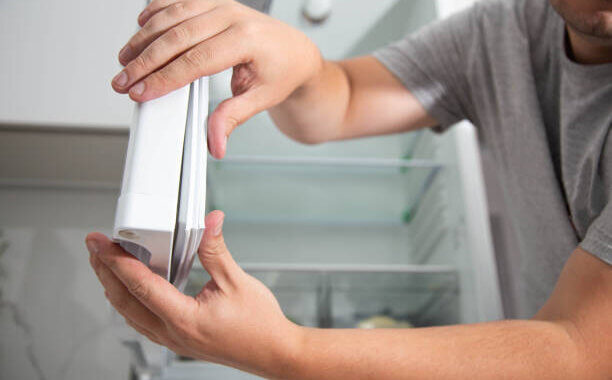Table of Contents
ToggleEasy Do It Yourself : Replacing Your Refrigerator Door Seal
Has the temperature inside your refrigerator dropped or has it started to run more frequently? A broken rubber gasket (seal) around the outside of your refrigerator door is one of the most commonly occurring issues. One of the simplest fridge repairs you can perform on your own is replacing the door seal. To learn everything you need to know to take out the old seal and replace it with a new one, this article is for you. In this article, we are going to discuss how to replace a refrigerator door seal. So any further waiting, let’s get into it.
Causes of the Refrigerator Gaskets or Door Seals Breaking
Gaskets and seals for refrigerator doors are made to last for many years, but with time, they may be damaged. A refrigerator door seal or gasket may break for multiple causes, including the following:
- The rubber in the seal may begin to dry out and become brittle as the refrigerator ages, which may lead to cracks or tears.
- Especially if the door is opened and closed frequently, the door seal is exposed to a lot of wear and tear over time. This may result in the seal being loose, which might reduce its capacity to form an airtight seal.
- There are several ways to cause damage to the seal, including slamming the door carelessly.
- If the seal is not cleaned on a regular basis, particles of dirt can build up on it and eventually cause it to become less flexible and rigid.
- If moisture enters the seal, it may deform or grow mold, which may compromise the seal’s capacity to maintain an airtight seal.
Check for Leaks or Damage on the Door Seal of Your Refrigerator
- Check for leaks or damage on the door seal of your refrigerator. Observe the rubber seal around the door’s edge when you open your refrigerator. It’s time for a replacement if you see any major cracks or holes in the rubber. Mold growth on the gasket is a strong indication of potential harm that may not be visible.
Refrigerator gaskets prevent heat from leaving and cold air from entering. The refrigerator’s temperature may rise, and food inside may spoil faster if the seal is damaged or cracked. Additionally, the cost of energy will increase.
- To check for a loose seal, slide a one dollar note between the gasket and the refrigerator. Place the one dollar note in the space between the refrigerator and the door, then shut the door. Next, make an effort to remove the currency note entirely from the seal. Your gasket is still in good shape if you detect a tiny dollar drag. It’s time to replace the door seal if the money falls out easily or has moisture on it.
- As another option, examine your refrigerator and freezer for any extra ice or moisture accumulation. When warm air from the outside leaks through the seal and condenses into water droplets, moisture is created inside your refrigerator. By repairing the seal, ice buildup can be avoided. Check other refrigerator parts, such as the condenser, to find out if they’re functioning properly if you see no issues but your refrigerator is still not functioning properly.
Try using silicone glue for sealing tiny cracks in an old gasket. Fill up some silicone sealant along the crack’s edge. Shut the refrigerator door slowly and keep it closed all night. In the morning, check the door seal once more to determine if the sealant has filled in the crack. Silicone sealant is not a long-term repair; it is only effective for small cracks. The door seal will ultimately develop more gaps and cracks, at which point you’ll need to replace it.
We also provide this service
Washing Machine Repair Services in Bangalore
Refrigerator Repair and Services in Bangalore

How to Replace the Door Seal?
Follows the steps written below to replace your refrigerator door seal or gasket:
Remove the Old Refrigerator Seal
To make the replacement refrigerator door gasket replacement easier, soak it in warm water for a few minutes while you remove the old one. Certain gaskets are secured to the door’s exterior by a metal retainer. To reveal the screws that secure the gasket in the retainer, lift the inner edge of the old gasket and release them. By holding the inner flange of the gasket and drawing it back, you may remove the old refrigerator door gasket. Pull out the old gasket by loosening the retention screws around the door’s perimeter with a hexagonal head nut driver that is the appropriate size, but do not remove them.
Replace the New Door Seal (Gasket)
Put in a fresh new fridge gasket. Push the gasket lip behind the metal retainer, beginning at one of the upper corners and working from there around the whole door. There is just one proper way for the gasket to fit. To snug up but not completely tighten the freezer gasket preservation screws, use a hex nut driver. After the repair, shut the door and see if it has warped. If required, hold onto the top and bottom to straighten it. Pull and push the door, shut it, and double-check that it is aligned correctly. Continue as needed, and then tighten the retainer screws all the way.
Apply Petroleum Jelly to the Gasket of the Refrigerator Door.
Examine how the refrigerator door sits with respect to the cabinet and other doors. Loosen the hinges on each side and realign the refrigerator or freezer door if it is drooping or excessively high. Lastly, just the gasket’s hinge side should have a thin coating of petroleum jelly applied to it in order to lessen freezer gasket drag.
Conclusion
Maintaining an effective refrigerator door seal is necessary for both energy conservation and proper food storage. If you want to extend the life of your refrigerator and save energy, check the seal on a regular basis. To guarantee that your refrigerator keeps working at its most efficient level, don’t be scared to replace a broken or damaged seal.



Leave a Reply